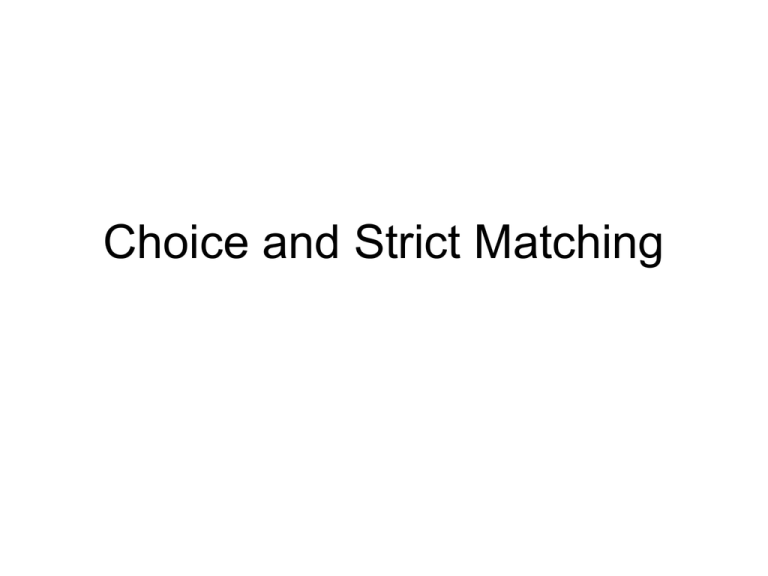operantchoice 3
advertisement

Choice and Strict Matching The Go-To Methodology: Conc VI VI ? VI 30 s VI 60 s Concurrent schedules -- schedules of choice Two ways of arranging concurrent schedules: A. Independent scheduling B. Dependent scheduling and, for each, there are two ways in which the schedules can be arranged: 1. the two-key (or N-key) procedure 2. the switching-key or Findlay or changeover procedure Independent vs. dependent scheduling With independent scheduling, each time-based schedule runs on its own. When a reinforcer is arranged on one schedule, it stops, but the other continues timing and may itself set up a reinforcer before the first one is taken. With dependent scheduling, when one schedule sets up a reinforcer, the other stops timing. The first reinforcer has to be collected before the second schedule will continue timing. Independent scheduling When you use independent scheduling, the subject could get all of its reinforcers from just one alternative and never change over. But, if it did this, it would not get the maximum reinforcer rate available. When you arrange dependent scheduling, if the subject responds only on one of the alternatives, the as soon as a reinforcer sets up on the other alternative, no more reinforcers at all will be obtained. Dependent scheduling is good because if you set up (for example) 4 times more reinforcers for one alternative than for the other, the subject will get 4 times more on the first alternative (within sampling error). You have a closely controlled independent variable. With independent scheduling, this may not happen so precisely, and may not happen at all. The other two procedures that can be used: The two-key (or N-key) procedure The two (or more) schedules are arranged at the same time on two (or more) operanda (levers, keys). The schedules run at the same time, and the subject is free to move between the operanda and schedules at any time. VI x s VI y s Switching-key procedure: Single peck - switching key -> changes the color and schedule of the main key on which reinforcers can be obtained. Note that both the schedules still run all the time until each one arranges a reinforcer -- even if the alternative is not displayed. VI x Switch Measures of choice in concurrent schedules 1. Response allocation: The number of responses emitted on each alternative Used to be measured as relative responses (the number of responses on one alternative divided by the total responses B1 B1 B 2 Proportional measure: ranges from 0 (all responses to B2) to 1 (all responses on B1) Measures of choice in concurrent schedules 1. Response allocation: The number of responses emitted on each alternative or, more recently, as response ratio (the number of responses on one key divided by the number of responses on the other key): B1 B2 This measure can range from 0 to infinity (and is not homoscedastic – it does not have constant variance) so… Measures of choice in concurrent schedules 1. Response allocation: The number of responses emitted on each alternative Often used: B1 log B2 This measure can range from minus infinity to infinity (and probably IS homoscedastic – it does have constant variance as we change things that affect choice) Measures of choice in concurrent schedules - continued 2. Time allocation: The amount of time spent on each alternative. This is measured from changeover response to changeover response in the switching-key procedure, or from the first response on one alternative to the first response on the other alternative in the two-key procedure. As above, the measures used may be relative time, or the time-allocation ratio. T1 T1 T 2 T1 T2 T1 log T2 Relative time allocation Time-allocation ratio Log time-allocation ratio * But are Time Measures that Simple? • Traditionally measured time – Is this missing something? • Elements of time – Pecking – Switching – Rf and post-rf Switch vs. Peck Time in 2 Alt Choice TIME PROPORTIONAL TO TOTAL TIME 1.0 Switch Proportion Time Post Rf Proportion Time Peck Proportion Time 0.8 0.6 0.4 0.2 0.0 -1.5 -1.0 -0.5 0.0 0.5 LOG REINFORCER RATIO 1.0 1.5 Response and time measures are usually very similar… • Independent of measures of choice – relative response-allocation and timeallocation ratios • Or procedure – Two-key or switching-key procedure – Independent versus dependent scheduling The changeover delay (COD) • COD: short period of time that must elapse between changing between alternatives and gaining a reinforcer that is already arranged. • Changeover delays eliminate concurrent superstitions -- which happens when a reinforcer for one response also reinforces responding on the other alternative. – Remember superstition lecture Reinforcer arranged on left 1 peck >2s 1 peck REINFORCER Thinking about Choice Behavior • The problem of choice – Organisms constantly bombarded with alternatives • What controls allocation of behavior? • How will behavior allocate? – When t’s are equal? – Slightly different? – Greatly different? The initial empirical finding -- Herrnstein (1961) VI VI 1.0 HERRNSTEIN (1961) BIRD 55 RELATIVE RESPONSES 0.8 BIRD 231 BIRD 641 0.6 0.4 0.2 STRICT MATCHING 0.0 0.0 0.2 0.4 0.6 RELATIVE REINFORCERS 0.8 1.0 Strict matching: Relative responses equals relative reinforcers obtained Simple quantitative relation: clearly something fundamental and important is going on… 1.0 HERRNSTEIN (1961) BIRD 55 RELATIVE RESPONSES 0.8 BIRD 231 BIRD 641 0.6 0.4 0.2 STRICT MATCHING 0.0 0.0 0.2 0.4 0.6 RELATIVE REINFORCERS 0.8 1.0 Why Study Choice? • • 1. The empirical relation -- Herrnstein (1961) 2. Because all behavior is fundamentally choice behavior (Herrnstein, 1971) – There is always a choice • • – – Other responses that can be emitted Other reinforcers that can be obtained -- even when you are reinforcing just one response (e.g., in a single VI schedule). An animal or a human can always do something else. Understand choice behavior -> understand all behavior So where do we start?: the strict matching law. Approximately, the proportion of responses emitted to one of the concurrent VI VI schedules equals the proportion of reinforcers obtained at that alternative 1.0 HERRNSTEIN (1961) BIRD 55 RELATIVE RESPONSES 0.8 BIRD 231 BIRD 641 0.6 0.4 0.2 STRICT MATCHING 0.0 0.0 0.2 0.4 0.6 RELATIVE REINFORCERS 0.8 1.0 The graph shows that, approximately, the proportion of responses emitted to one of the concurrent VI VI schedules equals the proportion of reinforcers obtained at that alternative This is the strict matching law, and its formula is: B1 R1 B1 B 2 R1 R 2 B = responses, R = reinforcers, and the Subscripts 1 and 2 denote the alternatives. Another way of writing the strict matching law: B1 R1 B1 B 2 R1 R 2 Cross multiply: B1( R1 R 2) R1( B1 B 2) B1R1 B1R 2 B1R1 B 2 R1 Subtract B1R1 from each side: B1 R 2 B 2 R1 so: B1 R1 B2 R2 B1 R1 B1 B 2 R1 R 2 is called the relative version of the strict matching law B1 R1 B2 R2 is called the ratio version of the strict matching law They both say exactly the same thing. Play around a bit more and you can get: B1 B 2 R1 R 2 What does this say? Research on strict matching Initially great empirical support. For example, Conger & Killeen (1974) - conversation Schroeder & Holland (1969) (over) Rats, pigeons, horses, cows, mice, cockroaches, ravens All sorts of responses, all sorts of reinforcers -- but not always strict matching Schroeder & Holland, 1969 What’s the organism? If your COD is long enough to eliminate concurrent superstitions, you get strict matching. Effect of COD Herrnstein’s Law AKA Herrnstein’s Hyperbola, the quantitative law of effect, the law of simple action Herrnstein (1970) developed a theory to extend the strict matching law to performance on single schedules: For single schedules: Herrnstein (1970) made the following assumptions: Herrnstein’s Assumptions: 1. That even in single-schedule situations, there are other responses than the ones we measure, and other reinforcers than the ones we provide. They are extraneous (or other) responses and reinforcers. These we will designate Be and Re. Herrnstein’s Assumptions: 2. The total rate of behavioral output is constant, and this constant is called k. Thus, for a two-alternative concurrent schedule, B1 + B2 + Be = k. Herrnstein’s Assumptions: 3. Strict matching applies. The subject divides its behavior proportionally between obtained R1 and R2 and Re and so on. Herrnstein’s Assumptions: 4. The value of Re is constant. Now for the equation… From Herrnstein's assumption of strict matching we know that: B1 R1 B1 Be R1 Re and from Herrnstein's constant-total output assumption we also assume that B1 Be k Thus we can write: B1 R1 , k R1 Re kR1 and thus B1 R1 Re kR 1 B1 R1 R e This is Herrnstein's equation, or Herrnstein's hyperbola, or the law of simple action. k and Re are assumed constants. And they have units, too: k is responses per minute if you measured B1 as responses per minute; Re is reinforcers per minute if you measured R1 as reinforcers per minute. R1 B1 k R1 Re k is the total output of behavior, and it is allocated to B1 according to the proportion of all reinforcers that are for this response (R1/(R1+R2)). The Context of Reinforcement Reinforcers for behaviors occur in the context of other reinforcers for other behaviors -- the bottom line of the equation: rft rate for this response kR 1 B1 R1 R e the context of reinforcement The rate of a behavior is controlled by the reinforcer rate for that behaviour in the context of all reinforcers in the situation. More on the context of reinforcement: Let’s look at the response rate on one alternative of a 2alternative concurrent VI VI schedule. The context of reinforcement is now: R1 R 2 Re So, the equation for B1 is: R1 B1 k . R1 R 2 Re Herrnstein’s Hyperbola -- Theory kR 1 B1 R1 R e The equation describes an hyperbola — variations in R1 when it is low change behavior a lot, but the same size variations in R1 when it is high change behavior only a little. - Diminishing marginal returns -- the changes decrease as the reinforcer rate increases. k = 100 B/m, Re = 5 R/h RESPONSES\MINUTE 100 80 Concave downwards 60 Negatively accelerated Diminishing marginal returns 40 20 0 0 20 40 60 RFS/HOUR 80 100 k = 100 B/m, Re = 5 R/h k = 100 B/m, Re = 20 R/h RESPONSES\MINUTE 100 80 60 40 20 0 0 20 40 60 RFS/HOUR 80 100 k = 100 B/m, Re = 5 R/h k = 40 B/m, Re = 5 R/h RESPONSES\MINUTE 100 80 60 40 20 0 0 20 40 60 RFS/HOUR 80 100 k = 100 B/M, Re = 20 R/H k = 40 B/M, Re = 20 R/h RESPONSES\MINUTE 100 80 60 40 20 0 0 20 40 60 RFS/HOUR 80 100 How well does Herrnstein’s Law fit the data? Herrnstein (1970) looked at the available data and fitted his hyperbola to them. - take the data, and change the values of k and Re until you get a good fit. -VAC: Goodness of fit is measured by the percentage of the variance in the data that is accounted for by the fitted values of k and Re . k and Re are free parameters Free Parameters • Free parameter: a value that you don’t know in any other way except by fitting the data -- there is no other way of knowing it. – Differences in individuals and situations • BUT can know how to change its value -for instance, – Animal less hungry-> Re should get bigger • Does Re change in the right direction when we change deprivation? – Yes • Are the values of k and Re reasonable? Herrnstein’s hyperbola: Data 120 RESPONSES PER MINUTE 100 DATA BEST FIT 80 BIRD P118 60 40 k = 113 responses/minute Re = 6.8 reinforcers per hour 20 VAC = 91% 0 0 50 100 150 200 REINFORCERS PER HOUR 250 300 Herrnstein’s hyperbola: Data 120 BIRD P129 DATA RESPONSES PER MINUTE 100 BEST FIT 80 60 40 k = 81 responses/minute Re = 13.8 reinforcers per hour 20 VAC = 77% 0 0 50 100 150 200 REINFORCERS PER HOUR 250 300 R e s p o n s e s p e r m i n u te Herrnstein’s hyperbola: Data 120 Bird P121 k = 104 responses/minute Re = 291 rfts/hour VAC = 84% 96 Data Fit 72 48 24 0 0 50 100 150 200 Reinforcers per hour 250 300 In general, the model fits the data well. The values of the free parameters (k and Re) look reasonable, and the different values seem to pick up very clear individual differences between the subjects. Modulus When you fit the model, the value of k that you obtain is in terms of the measure you have taken. If the pigeon was key pecking for food, it is in pecks/minute; if it is lever pressing, it is in terms of lever-presses per minute. In other words, k is measured in the modulus of the behavior that you are reinforcing. Modulus The same is true for Re— it is measured in terms of R1. If R1 consists of 3-s access to grain, then Re is measured in these terms. So, in the previous graphs, Re is strictly "equivalent foodreinforcer per hour“ – if you have arranged 3-s access to grain, Re will be measured in “3-s access to grain equivalents per hour” Avoidance 40 DE VILLIERS (1974) - BIRD R8 DATA RESPONSES PER MINUTE BEST FIT 30 k = 58 responses/minute Re = 6.4 SHOCKS PER MINUTE VAC = 100% 20 10 0 0.0 0.5 1.0 1.5 2.0 2.5 REINFORCERS PER HOUR REINFORCERS PER MINUTE 3.0 3.5 Avoidance 40 DE VILLIERS (1974) - BIRD R3 DATA RESPONSES PER MINUTE BEST FIT 30 k = 24 responses/minute Re = 1.3 SHOCKS PER MINUTE VAC = 98% 20 10 0 0.0 0.5 1.0 1.5 2.0 2.5 REINFORCERS PER HOUR REINFORCERS PER MINUTE 3.0 3.5 Avoidance 40 DE VILLIERS (1974) - BIRD R13 DATA RESPONSES PER MINUTE BEST FIT 30 20 k = 48 responses/minute Re = 1.2 SHOCKS PER MINUTE 10 VAC = 97% 0 0.0 0.5 1.0 1.5 2.0 2.5 3.0 REINFORCERS PER HOUR REINFORCERS PER MINUTE 3.5 4.0 Herrnstein’s Hyperbola -- Application kR 1 B1 R1 R e Given this equation: What two ways could we reduce B? Herrnstein's law and concurrent schedules The strict-matching equations for describing rates of responding during either alternative in concurrent VI VI schedules are: Alternative 1: B1 R1 , B1 B 2 Be R1 R 2 Re Alternative 2: B2 R2 B1 B 2 Be R1 R 2 Re According to Herrnstein's assumptions, the denominators (B1 + B2 + Be) both equal k, so: kR1 B1 , R1 R 2 Re and kR2 B2 R1 R 2 Re If now we divide B1 by B2 to see what relative behaviour allocation would look like, we get: B1 R1 B2 R2 As we saw already, this is just the same relation as: B1 R1 B2 R2 which is the strict matching law. B1 R1 B1 B 2 R1 R 2 So, the response rate on one of the schedules comprising a concurrent VI VI schedule is: kR1 B1 , R1 R 2 Re How good is Herrnstein's law (1)? A law is only as good as the assumptions are true. It fits the data well, But is that enough? -- many other equations could be good fits. How good is Herrnstein's law (2)? The assumption about Re existing -- that there are other reinforcers available -- cannot be faulted. Logically, it seems that this must be correct. BUT the assumption that Re remains constant when R1 is varied is probably unreasonable. It seems unlikely that Re could remain constant when Be varies considerably. Re surely must fall when R1 is increased. How good is Herrnstein's law (3)? The assumption that total output (k) is constant seems counter-intuitive, but it could be correct if you measure all the responses in the same modulus -- which Herrnstein's theory does. Even doing nothing is behaving. How good is Herrnstein's law (4)? The assumption of strict matching is likely to be wrong. Considerable research has shown that the behavior ratio changes rather less with changes in reinforcer ratios than is suggested by strict matching. Extensions of strict matching Application of strict matching Experimental Analysis of Choice • Methods: concurrent schedules, concurrent chains, delay discounting, foraging contingencies, behavioral economic contingencies. • Models and Issues: matching/melioration, maximizing/optimality, hyperbolic discounting, behavioral economic/ecological models, behavior momentum, molar versus molecular issue, concepts of response strength. • Applications: self-control, drug abuse, gambling, risk, economics, behavioral ecology, social/political decision making. B1 r1 B1 B 2 r1 r 2 Assume B1 B 2 k . B1 r1 k r1 r 2 Set B1= B, r1= r, and r2= ro, where ro represents other sources of reinforcement. Thus, kr B r ro Herrnstein's Hyperbola








